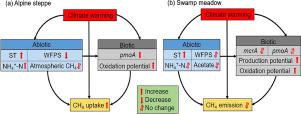当前位置:
X-MOL 学术
›
Agric. For. Meteorol.
›
论文详情
Our official English website, www.x-mol.net, welcomes your
feedback! (Note: you will need to create a separate account there.)
Warming effects on methane fluxes differ between two alpine grasslands with contrasting soil water status
Agricultural and Forest Meteorology ( IF 5.6 ) Pub Date : 2020-08-01 , DOI: 10.1016/j.agrformet.2020.107988 Fei Li , Guibiao Yang , Yunfeng Peng , Guanqin Wang , Shuqi Qin , Yutong Song , Kai Fang , Jun Wang , Jianchun Yu , Li Liu , Dianye Zhang , Kelong Chen , Guoying Zhou , Yuanhe Yang
Agricultural and Forest Meteorology ( IF 5.6 ) Pub Date : 2020-08-01 , DOI: 10.1016/j.agrformet.2020.107988 Fei Li , Guibiao Yang , Yunfeng Peng , Guanqin Wang , Shuqi Qin , Yutong Song , Kai Fang , Jun Wang , Jianchun Yu , Li Liu , Dianye Zhang , Kelong Chen , Guoying Zhou , Yuanhe Yang

|
Abstract Soil moisture plays a vital role in regulating the direction and magnitude of methane (CH4) fluxes. However, it remains unclear whether the responses of CH4 fluxes to climate warming exhibit difference between dry and moist ecosystems. Based on standardized manipulative experiments (i.e., consistent experimental design and measurement protocols), here we explored warming effects on growing season CH4 fluxes in two alpine grasslands with contrasting water status on the Tibetan Plateau. We observed that experimental warming enhanced CH4 uptake in the relatively arid alpine steppe, but had no significant effects on CH4 emission in the moist swamp meadow. The distinct responses of CH4 fluxes were associated with the different warming effects on biotic and abiotic factors related to CH4 oxidation and production processes. Warming decreased soil water-filled pore space (WFPS) and increased the pmoA gene abundance and CH4 oxidation potential in the alpine steppe, which together led to a significant increase in CH4 uptake at this alpine steppe site. However, warming-induced enhancement in CH4 oxidation potential might be counteracted by the simultaneously increased CH4 production potential in the swamp meadow, which could then result in insignificant warming effects on CH4 emission at this swamp meadow site. Based on a meta-analysis of warming effects on CH4 fluxes across the entire Tibetan Plateau, we found that the entire alpine grasslands could absorb an extra 0.042 Tg CH4 (1 Tg = 1012 g) per growing season if soil temperature increased by 1 °C. These findings demonstrate that warming effects on CH4 fluxes differ between two alpine grasslands with contrasting moisture conditions and the entire alpine grasslands may not trigger a positive CH4 feedback to climate system with moderate warming.
中文翻译:

两种土壤水分状况不同的高寒草原变暖对甲烷通量的影响不同
摘要 土壤水分在调节甲烷(CH4)通量的方向和大小方面起着至关重要的作用。然而,尚不清楚 CH4 通量对气候变暖的响应是否表现出干湿生态系统之间的差异。基于标准化的操作实验(即一致的实验设计和测量方案),我们在此探索了青藏高原两个具有对比水状况的高寒草地对生长季 CH4 通量的变暖效应。我们观察到实验性变暖增强了相对干旱的高山草原的 CH4 吸收,但对潮湿沼泽草甸的 CH4 排放没有显着影响。CH4 通量的不同响应与对与 CH4 氧化和生产过程相关的生物和非生物因素的不同变暖影响有关。变暖降低了高山草原的土壤充满水的孔隙空间 (WFPS),增加了 pmoA 基因丰度和 CH4 氧化电位,共同导致该高山草原站点 CH4 吸收显着增加。然而,变暖引起的 CH4 氧化势增强可能会被沼泽草甸中 CH4 生产潜力的增加抵消,这可能导致对该沼泽草甸场地 CH4 排放的变暖效应不显着。基于对整个青藏高原 CH4 通量的变暖效应的荟萃分析,我们发现,如果土壤温度升高 1°C,整个高山草原每个生长季可额外吸收 0.042 Tg CH4(1 Tg = 1012 g) .
更新日期:2020-08-01
中文翻译:

两种土壤水分状况不同的高寒草原变暖对甲烷通量的影响不同
摘要 土壤水分在调节甲烷(CH4)通量的方向和大小方面起着至关重要的作用。然而,尚不清楚 CH4 通量对气候变暖的响应是否表现出干湿生态系统之间的差异。基于标准化的操作实验(即一致的实验设计和测量方案),我们在此探索了青藏高原两个具有对比水状况的高寒草地对生长季 CH4 通量的变暖效应。我们观察到实验性变暖增强了相对干旱的高山草原的 CH4 吸收,但对潮湿沼泽草甸的 CH4 排放没有显着影响。CH4 通量的不同响应与对与 CH4 氧化和生产过程相关的生物和非生物因素的不同变暖影响有关。变暖降低了高山草原的土壤充满水的孔隙空间 (WFPS),增加了 pmoA 基因丰度和 CH4 氧化电位,共同导致该高山草原站点 CH4 吸收显着增加。然而,变暖引起的 CH4 氧化势增强可能会被沼泽草甸中 CH4 生产潜力的增加抵消,这可能导致对该沼泽草甸场地 CH4 排放的变暖效应不显着。基于对整个青藏高原 CH4 通量的变暖效应的荟萃分析,我们发现,如果土壤温度升高 1°C,整个高山草原每个生长季可额外吸收 0.042 Tg CH4(1 Tg = 1012 g) .











































 京公网安备 11010802027423号
京公网安备 11010802027423号